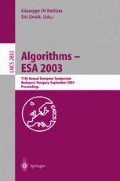Abstract
The achromatic number of a graph is the largest number of colors needed to legally color the vertices of the graph so that adjacent vertices get different colors and for every pair of distinct colors c 1,c 2 there exists at least one edge whose endpoints are colored by c 1,c 2. We give a greedy O(n 4/5) ratio approximation for the problem of finding the achromatic number of a bipartite graph with n vertices. The previous best known ratio was n ·loglog n / log n [12]. We also establish the first non-constant hardness of approximation ratio for the achromatic number problem; in particular, this hardness result also gives the first such result for bipartite graphs. We show that unless NP has a randomized quasi-polynomial algorithm, it is not possible to approximate achromatic number on bipartite graph within a factor of (ln n)1/4 − ε. The methods used for proving the hardness result build upon the combination of one-round, two-provers techniques and zero-knowledge techniques inspired by Feige et.al. [6].
Access this chapter
Tax calculation will be finalised at checkout
Purchases are for personal use only
Preview
Unable to display preview. Download preview PDF.
References
Bodlaender, H.L.: Achromatic number is NP-complete for cographs and interval graphs. Inform. Process. Lett. 31(3), 135–138 (1989)
Cairnie, N., Edwards, K.: Some results on the achromatic number. J. Graph Theory 26(3), 129–136 (1997)
Chaudhary, A., Vishwanathan, S.: Approximation algorithms for the achromatic number. In: Proceedings of the Eighth Annual ACM-SIAM Symposium on Discrete Algorithms, pp. 558–563 (1997)
Edwards, K.: The harmonious chromatic number and the achromatic number. Surveys in combinatorics, London, 13–47 (1997)
Farber, M., Hahn, G., Hell, P., Miller, D.: Concerning the achromatic number of graphs. J. Combin. Theory Ser. B 40(1), 21–39 (1986)
Feige, U., Halldórsson, M., Kortsarz, G., Srinivasan, A.: Approximating the domatic number. Accepted to Siam J. on Computing conditioned on a revision
Halldórsson, M.M.: Approximating the minimum maximal independence number. Inform. Process. Lett. 46(4), 169–172 (1993)
Hastad, J.: Clique is Hard to Approximate within n to the power 1-epsilon. Acta Mathematica 182, 105–142 (1999)
Hell, P., Miller, D.J.: On forbidden quotients and the achromatic number. In: Proceedings of the 5th British Combinatorial Conference, pp. 283–292 (1975); Congressus Numerantium, No. XV. Utilitas Math. (1976)
Hell, P., Miller, D.J.: Achromatic numbers and graph operations. Discrete Math. 108(1-3), 297–305 (1992)
Hughes, F., MacGillivray, G.: The achromatic number of graphs: a survey and some new results. Bull. Inst. Combin. Appl. 19, 27–56 (1997)
Kortsarz, G., Krauthgamer, R.: On approximating the achromatic number. Siam Journal on Discrete Mathematics 14(3), 408–422
Krysta, P., Loryś, K.: Efficient approximation algorithms for the achromatic number. In: Nešetřil, J. (ed.) ESA 1999. LNCS, vol. 1643, pp. 402–413. Springer, Heidelberg (1999)
Máté, A.: A lower estimate for the achromatic number of irreducible graphs. Discrete Math. 33(2), 171–183 (1981)
Yannakakis, M., Gavril, F.: Edge dominating sets in graphs. SIAM J. Appl. Math. 38(3), 364–372 (1980)
Author information
Authors and Affiliations
Editor information
Editors and Affiliations
Rights and permissions
Copyright information
© 2003 Springer-Verlag Berlin Heidelberg
About this paper
Cite this paper
Kortsarz, G., Shende, S. (2003). Approximating the Achromatic Number Problem on Bipartite Graphs. In: Di Battista, G., Zwick, U. (eds) Algorithms - ESA 2003. ESA 2003. Lecture Notes in Computer Science, vol 2832. Springer, Berlin, Heidelberg. https://doi.org/10.1007/978-3-540-39658-1_36
Download citation
DOI: https://doi.org/10.1007/978-3-540-39658-1_36
Publisher Name: Springer, Berlin, Heidelberg
Print ISBN: 978-3-540-20064-2
Online ISBN: 978-3-540-39658-1
eBook Packages: Springer Book Archive

